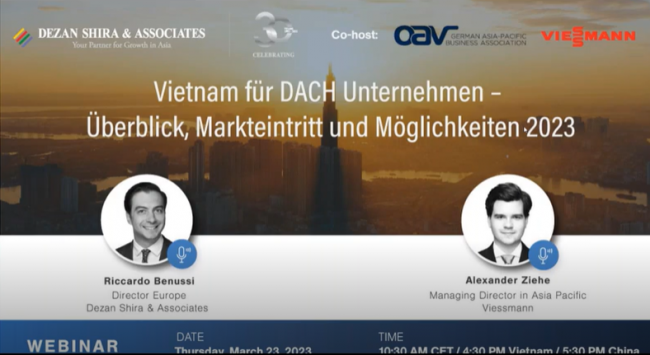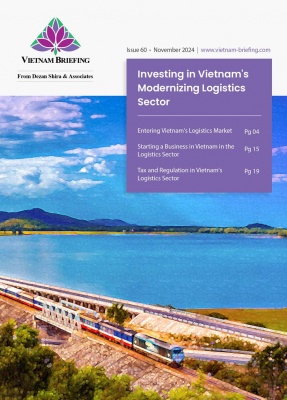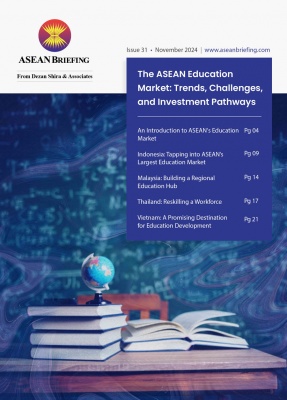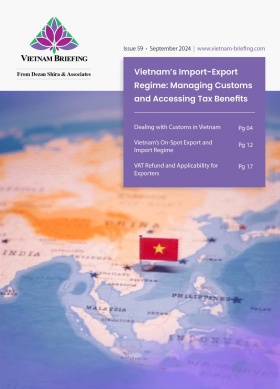How Vietnam Will Implement the Global Minimum Tax: Draft Decree Guiding Resolution 107
We discuss the Vietnam draft decree outlining the implementation of Resolution 107 and the Global Minimum Tax (GMT) under GloBE rules, introducing tax administration requirements and corporate income tax measures to combat tax avoidance by multinational corporations.
On November 12, 2024, Vietnam’s Ministry of Finance published a draft decree guiding the implementation of Resolution No. 107/2023/QH15 (“Resolution 107”), which details the application of a top-up tax under the global anti-base erosion (GloBE) rules. The draft is part of Vietnam’s ongoing effort to enact the Global Minimum Tax (GMT) initiative, aimed at addressing tax avoidance and profit shifting by multinational corporations.
The draft decree, following the recent completion of its public consultation period, provides stakeholders with insights into the Vietnamese government’s next steps regarding GMT implementation. It introduces tax admin requirements and potential corperate income tax measures in line with the GloBE rules, applicable for in-scope taxpayers.
This article examines important provisions in the draft decree and their implications for businesses’ tax compliance in Vietnam.
To understand more about the background of Vietnam’s GMT application, also read: Global Minimum Tax (GMT) in Vietnam
Overview of the draft decree
The GMT regulation applies in Vietnam from the 2024 financial year, specifically:
- For fiscal years beginning on or after January 1, 2024.
- If a Constituent Entity (CE) follows the Ultimate Parent Company’s (UPC) 2024 financial year, which starts within December 2023, that financial year will still be considered the 2024 financial year for GMT application in Vietnam.
Businesses should closely monitor the draft decree to ensure optimal compliance.
The draft decree is structured into three parts:
- Part I – General Provisions: Contains three articles outlining the scope of implementation, applicable subjects, and targeted taxpayers.
- Part II – Specific Provisions: Comprises 19 articles across four chapters, covering regulations on:
- Qualified Domestic Minimum Top-up Tax (QDMTT);
- Income Inclusion Rule (IIR);
- Liability forwarding and reduction; and
- Tax declaration, payment, and management.
- Part III – Implementation Terms
Targeted taxpayers under the draft decree
Taxpayers subject to the draft decree are CEs of multinational companies with annual consolidated revenue of €750 million or more in at least two of the four preceding fiscal years, except in the following cases:
- Government organizations;
- International organizations;
- Non-profit organizations;
- Pension funds;
- Investment funds that are the ultimate parent companies;
- Real estate investment organizations that are the ultimate parent companies; and
- Organizations with at least 85 percent of the value of assets owned directly or indirectly through organizations specified under Resolution 107.
In addition, the draft decree stipulates the method of determining revenue thresholds in certain special cases, such as:
- Newly established multinational corporations less than 4 years old;
- Multinational corporations with accounting periods other than 12 months; and
- Multinational corporations after mergers and acquisitions, etc.
Key highlights regarding tax admin requirements of the draft decree
QDMTT application
The draft decree prescribes application upon both inbound multinational companies, foreign parent entities with operations in Vietnam, and Vietnamese-headquartered multinational businesses. However, QDMTT does not apply to stateless constituent entities, stateless permanent establishments (PEs), investment entities or insurance investment entities.
For the QDMTT application, the financial year of Vietnam’s constituent entities will match that of their ultimate parent companies, helping to enhance consistency and facilitate group compliance.
Applied accounting standards
Under the draft decree, QDMTT will be determined by the financial accounting standards used for consolidated financial statements of UPEs.
If a constituent entity is unable to determine its net income or loss using these standards, it shall employ another acceptable or authorized financial accounting standard, such as the Vietnamese Accounting Standard.
However, the draft decree requires the entity to make adjustments for permanent differences over €1 million that result from discrepancies between these standards and the standards used for consolidation.
Currency for calculating QDMTT
The QDMTT calculation is conducted using the currency in which the UPE prepares its consolidated financial statements, with the following guidelines for foreign exchange rates:
- Vietnamese Dong (VND): Revenue, income, and other monetary thresholds should be determined using the average of the central foreign exchange rates or the average of the cross foreign exchange rates for December of the year prior to when the revenue or income was generated, as quoted by the State Bank of Vietnam.
- Other currencies: The average foreign exchange rates for December of the year immediately preceding the year when the revenue or income was generated should be used, as quoted by the European Central Bank (ECB).
- If the ECB does not provide foreign exchange rates for the currency used in the UPE’s consolidated financial statements: The average foreign exchange rates for December of the year immediately preceding the year of generating revenue or income should be used, as quoted by the State Bank in the jurisdiction of the UPE.
The resulting top-up tax has to be converted into VND for payment into the State Budget.
Filing and administration
If the multinational enterprise has more than one CE in Vietnam, one of them must be designated to pay the QDMTT. If not, the tax authority will select the CE with the greatest total asset value.
The nominated entity must follow the timeline outlined below:
- Within 30 days of the financial year-end: Submit written notice nominating the filing CE.
- Within 90 days of the financial year-end: Submit an application to obtain a tax code for tax declaration and payment. In the case of a change in the CE responsible for declarations: The new filling CE continues to use the tax code that has been issued and inherits the tax obligations of the previous CE.
- Within 9 months of the financial year-end: Provide the General Department of Taxation with a list of CEs within the group in Vietnam that are subject to the QDMTT. In the case of changes, notify the tax authority no later than the deadline for submitting QDMTT/IIR return and supplementary CIT return.
- Within 12 months of the financial year-end: Submit the following documents:
- QDMTT return;
- Supplementary CIT return;
- Explanation of discrepancies due to differences in accounting standards; and
- Report of financial data of each CE used for preparing the consolidated financial statements of UPE.
- Within 18 months for the first year (15 months for subsequent years): Submit the following documents:
- IIR return
- Supplementary CIT return;
- Explanation of discrepancies due to differences in accounting standards;
- Report of financial data of each CE used for preparing the consolidated financial statements of UPE; and
- Consolidated FS of the UPE.
Transitional safe harbor and transitional penalty relief
Safe harbor
The Safe Harbour provisions under the GMT framework allow multinational companies to adjust to new regulations starting from the financial year ending in 2024. During this period, no extra top-up tax will be levied if:
- The multinational corporate group reports total revenues beneath €10 million and profits before tax under €1 million, or shows a loss according to its qualified country-by-country Report (CbCR).
- The group uses a simplified effective tax rate that meets or surpasses the transition rates: 15 percent for fiscal years 2023 and 2024, 16 percent for 2025, and 17 percent for 2026.
- Profit before tax in the jurisdiction does not exceed the substance-based income exclusion amount as specified by the GloBE rules, as indicated in the CbCR.
Penalty relief during the transitional period
During the transition period (applicable to fiscal years beginning on or before December 31, 2026, but excluding fiscal years ending after June 30, 2028), no administrative penalties will be imposed for the following tax administrative violations:
- Late tax registration, late notification of the appointment of a filing Constituent Entity (CE), or late payment of top-up taxes, provided the delay does not exceed 90 days after the deadline.
- Late notification of changes in tax registration after the deadline, provided there is no change to the tax registration certificate or tax identification number.
- Late notification of changes in tax registration up to 90 days after the deadline, resulting in changes to the tax registration certificate or tax identification number.
- False or incomplete declarations that do not result in a shortfall in the tax payable amount.
- Late submission of a tax declaration, provided the delay does not exceed 90 days after the deadline.
- Late submission of a tax declaration beyond 91 days after the deadline, provided no tax payable amount is incurred.
- Late submission of a tax declaration beyond 91 days after the deadline, where tax is payable, but the taxpayer has fully settled the tax amount and late payment interest before the Tax Authority announces a tax audit/inspection decision or records the late submission.
- False or incomplete tax declarations leading to a shortfall in payable tax amounts, provided the transactions are fully recorded in the accounting books with valid invoices and legal documents, and the taxpayer has voluntarily paid the full underpaid tax and late payment interest before the competent authority issues an administrative violation sanction.
Conclusion
The draft decree marks a significant step in aligning Vietnam’s tax practices with global standards. It establishes specific provisions for QDMTT and clarifies the responsibilities of multinational companies operating in the country.
Yet, while the GMT in Vietnam applies from the 2024 fiscal year, no official announcement on its publication has been made as of this article’s release.
Businesses are thus advised to remain proactive in monitoring developments and preparing for compliance to mitigate potential tax liabilities. Early engagement with the decree’s provisions will be essential for effective tax management and adherence to Vietnam’s evolving tax regulations.
For any inquiries, please contact our tax experts at Vietnam@dezshira.com
About Us
Vietnam Briefing is published by Asia Briefing, a subsidiary of Dezan Shira & Associates. We produce material for foreign investors throughout Asia, including ASEAN, China, and India. For editorial matters, contact us here and for a complimentary subscription to our products, please click here. For assistance with investments into Vietnam, please contact us at vietnam@dezshira.com or visit us at www.dezshira.com.
Dezan Shira & Associates assists foreign investors throughout Asia from offices across the world, including in Hanoi, Ho Chi Minh City, and Da Nang. We also maintain offices or have alliance partners assisting foreign investors in China, Hong Kong SAR, Dubai (UAE), Indonesia, Singapore, Philippines, Malaysia, Thailand, Bangladesh, Italy, Germany, the United States, and Australia.
- Previous Article Vietnam’s Regulatory Framework for Corporate Restructuring
- Next Article Dispute Resolution Methods in Vietnam and the Advantages of Arbitration
































